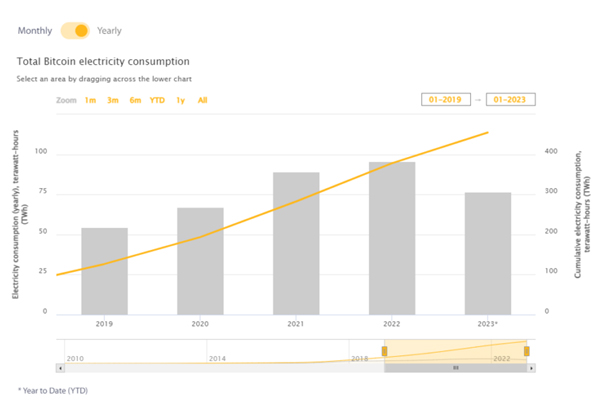
Recent data from the Cambridge Centre for Alternative Finance (CCAF) suggests a more optimistic view of Bitcoin’s environmental impact. The electricity required to mine Bitcoin has been revised downward to 89 Terawatt hours (TWh), a 15 TWh reduction from earlier estimates.
These new findings offer a refreshed perspective on the long-term environmental sustainability of Bitcoin.

Reassessing Bitcoin’s Environmental Footprint
Historical data from CCAF indicates that previous estimates for Bitcoin’s electricity consumption have been readjusted, leading to a change in our understanding of its ecological impact.
Before 2021, consumption figures stayed relatively stable. However, a shift occurred in 2021 when initial estimates suggested Bitcoin was consuming 104 TWh. The revised model now puts that figure at just 89 TWh.
Estimates for 2022 have also been revised, dropping from 105.3 TWh to 95.5 TWh, putting it on par with the energy usage of countries like Belgium or the Netherlands.
As of 2023, the year-to-date consumption has further decreased to 70.4 TWh, illuminating an often-overlooked aspect of the cryptocurrency — its increasing energy efficiency.
Why the Change?
The CCAF credits the adjustment to a new methodology that more accurately gauges the efficiency of older mining devices. Previously, all devices were equally weighted in energy consumption assessments. Now, devices are evaluated based on their respective launch dates, which has led to the lowered annual electricity consumption figures for Bitcoin.
Moreover, data shows that Bitcoin’s hardware efficiency is improving. The efficiency, measured in joules per terahash (J/TH), indicates the electricity needed for computation. The updated model shows that the efficiency for 2021 stood at 63.6 J/TH, significantly better than the previously estimated 74.2 J/TH.
Beyond Electricity Consumption
While electricity consumption is a critical factor in evaluating Bitcoin’s environmental impact, it’s not the only one. The types of energy sources utilized in Bitcoin mining and their geographical locations are also important considerations.
Researchers are increasingly exploring other variables, such as the possibility of reducing methane emissions by situating mining operations near oil fields or using waste-heat recovery systems. These innovative strategies could provide further opportunities to mitigate Bitcoin’s environmental impact.
Ongoing Research and Implications
The CCAF, supported by major public and private institutions, continues to provide open-access research that is vital for stakeholders and helps foster a more nuanced public conversation.
Though the exact electricity consumption of Bitcoin remains a moving target, the recent revisions in estimates provide a more optimistic scenario for the cryptocurrency’s environmental sustainability.
Sentiment: Positive
See also